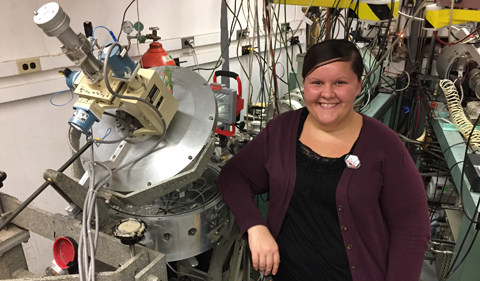Ohio University physics doctoral student Andrea Richard published an article about understanding the structure of neutron-rich magnesium isotopes in the American Physical Society’s Physical Review C, a peer-reviewed journal covering leading research in nuclear physics.
Her paper, “Strongly coupled rotational band in 33Mg,” describes her research on the ground-state rotational band structure observed in the neutron-rich magnesium isotope 33Mg, based upon data taken at the National Superconducting Cyclotron Laboratory at Michigan State University. The goal of the experiment was to observe rotational bands in the “island of inversion” magnesium isotopes using gamma-ray spectroscopy with GRETINA (Gamma Ray Energy Tracking In-Beam Nuclear Array).
An island of inversion is a region of the nuclear chart where isotopes appear to fill the single-particle levels of the nuclear shell model in an unexpected way, with protons or neutrons excited from one major shell to the next, even in their ground state.
“The island of inversion is centered on the neutron-rich magnesium isotopes having approximately 20 neutrons or more,” explains Richard. “This paper presents the analysis of the observed gamma-rays in 33Mg and offers an interpretation of the constructed level scheme as well as other available experimental data in the strong coupling limit of the rotational model.”
Many measurements have been made on the properties of the island of inversion isotopes, which have long been thought to be deformed, but until this experiment, rotational band structures, which are the fingerprints of deformation, had not been observed. Additionally, Richard and the co-authors presented an interpretation of the data and other available experimental observables for 33Mg and a consistent picture emerged for all of the observables.
“Andrea’s work on 33Mg is part of the basic science research program to answer the over-arching questions about nuclear structure, such as how nuclei are made and organized,” says Dr. Heather Crawford, Adjunct Professor of Physics & Astronomy and Staff Scientist at the Lawrence Berkeley National Laboratory. “We’re always trying to work toward developing a description of the atomic nucleus that is valid across the entire Segre chart of nuclides, and each piece of data provides a test of our models and a possibility to refine our understanding.”
When Research Merits Rapid Communication
Richard’s paper merits a Rapid Communication owing primarily to the interpretation of the data she analyzed, says Crawford. 33Mg is near the center of a well-studied region of the nuclear chart known as the N=20 Island of Inversion which is, researchers believe, fairly well-understood in terms of the nuclear shell model, and excitations of neutrons.
“Within the framework often used, this nucleus and its neighbors are believed to be deformed, but haven’t typically been interpreted in a traditional deformed/rotational framework,” Crawford explains. “Andrea’s work placed a new excited state in 33Mg, that when combined with other data, allowed an analysis of the low-energy structure in a straight-forward rotational framework that describes the data remarkably well. The simplicity of the description provides insight into the structure which is worth noting, and the referees for PRC Rapid Communication agreed.”
Teamwork and a Previous Collaborative Study
The paper is a result of many researchers working together over a period of three years. The majority of the authors were primarily engaged during the measurement itself at NSCL, in taking shifts during the beam time. The main authors however collaborated not only at NSCL, but also during Richards’s time at LBNL under her graduate U.S. Department of Energy award, and via regular discussions over Skype.
Richard has been working on similar research with Crawford and other collaborators at Berkeley lab and NSCL since early 2014. They published a paper, “Rotational band structure in 32Mg” from the same data set on the neighboring isotope, 32Mg, on which Richard was a coauthor last year, which also appeared as a Rapid Communication.
Using GRETINA, a World-Class Traveling Spectrometer Facility
GRETINA is the first U.S. realization of a gamma-ray tracking array. It is a gamma-ray spectrometer which is optimized for fast-beam nuclear physics such as the measurement the researchers performed at NSCL. This is a cutting-edge facility for the community that has run in-beam gamma-ray spectroscopy physics campaigns at both National Superconducting Cyclotron Laboratory and ATLAS at Argonne National Laboratory.
GRETINA is also the predecessor for GRETA, the 4pi ‘Gamma-Ray Energy Tracking Array’, which is a project now getting started and led at Lawrence Berkeley National Laboratory. GRETA will use the technology of GRETINA and grow the array to cover the maximal solid angle to become the world’s most powerful gamma-ray spectrometer.
In the United States, GRETINA is a traveling spectrometer facility, and has performed physics campaigns at NSCL as well as at the ATLAS facility at Argonne National Lab. GRETINA also has a counter-part in Europe, the Advanced GAmma Track Array, which has performed physics campaigns at a number of European facilities.
Due to the resolving power of GRETINA, Richard and her co-authors were able to measure new physics in the island of inversion and to say with more certainty that these nuclei are deformed.
“This could not have been accomplished without the effort of the accelerator operations team at NSCL, and our collaborators at NSCL, ANL, and LBNL,” Richard says. “The group at LBNL, specifically Heather Crawford, Paul Fallon, and Augusto Macchiavelli, was especially helpful and vital to the success of the project.”




















One Comment